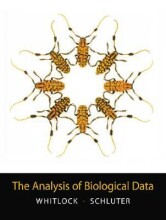Summary: The Analysis Of Biological Data | 9780981519401 | Michael C Whitlock, et al
- This + 400k other summaries
- A unique study and practice tool
- Never study anything twice again
- Get the grades you hope for
- 100% sure, 100% understanding
Read the summary and the most important questions on The analysis of biological data | 9780981519401 | Michael C. Whitlock and Dolph Schluter.
-
1 Statistics and samples
This is a preview. There are 1 more flashcards available for chapter 1
Show more cards here -
1.3 Types of data and variables
This is a preview. There are 3 more flashcards available for chapter 1.3
Show more cards here -
If we want to assess how high blood pressure leads to strokes, what is the explanatory variable? Why?
High blood pressure is the explanatory variable, since it predicts the risk of getting a stroke (response variable) -
What is the difference between nominal categorical data and ordinal categorical data?
Nominal categorical data means the categories have no inherent order. (names)
Ordinal categorical data can be ordered, despite of lack magnitude on the ordinal scale. (stage, score, size class etc.) -
1.4 Frequency distributions and probability distributions
This is a preview. There are 1 more flashcards available for chapter 1.4
Show more cards here -
What does the frequency distribution describe about the variable of a sample?
The frequency distribution describes how many times each value of a variable occurs in a sample -
What is the difference and the relation between a probability distribution and a normal distribution?
A probability distribution describes the whole population.
A normal distribution is a theoretical probablity distribution of a continuous variable. -
Which type of treatment assignment is classified as an observational study?
When natureassigns treatment groups of values of anexplanatory variable to the individuals. -
2 Displaying data
This is a preview. There are 2 more flashcards available for chapter 2
Show more cards here -
2.2 Quantiles of a frequency distribution
-
What does a quantile of an observation describe?
The value below which thequantile of observation lies. F.e. Aquantile of 0.10, means that 10% of the observations lie below the observation. -
What does a percentile of an observation desribe?
The percentage of observations that lie below the observation. -
3 Describing data
This is a preview. There are 1 more flashcards available for chapter 3
Show more cards here -
What do descriptice statistics do?
They are quantities that capture important features of frequency distributions. -
3.1 Arithmetic mean and standard deviation
This is a preview. There are 14 more flashcards available for chapter 3.1
Show more cards here -
What is the most common metric to describe a frequency distribution?
The (arithmetric ) mean -
What is the relationship between the variance and the standard deviation?
The sd is calculated form the variance, as the square root of the variance.
- Higher grades + faster learning
- Never study anything twice
- 100% sure, 100% understanding
Topics related to Summary: The Analysis Of Biological Data
-
Describing data - Arithmetic mean and standard deviation
-
Describing data - Median and interquartile range
-
Describing data - How measures of location and spread compare
-
Estimating with uncertainty - The sampling distribution of an estimate
-
Estimating with uncertainty - Measuring the uncertainty of an estimate
-
Estimating with uncertainty - Confidence intervals
-
Hypothesis testing - Making and using hypothesis
-
Hypothesis testing - One sided tests
-
Fitting probability models to frequency data
-
Contingency analysis - Odds ratio
-
Contingency analysis - The X2 contingency test
-
Correlation between Numerical Variables - Estimating a linear correlation coefficient
-
Correlation between Numerical Variables - TEsting the null hypothesis of zero correlation
-
Correlation between Numerical Variables - Assumptions
































